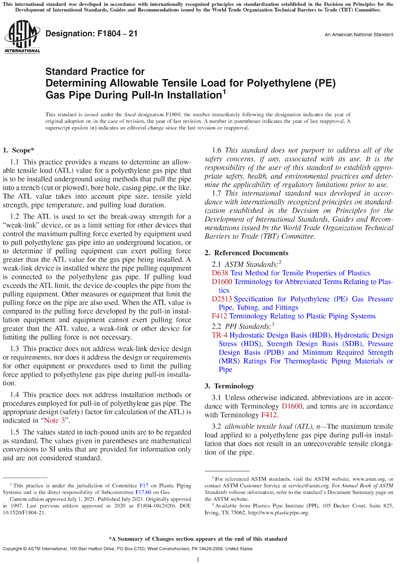Most recent
ASTM F1804-21
Standard Practice for Determining Allowable Tensile Load for Polyethylene (PE) Gas Pipe During Pull-In Installation
1.1This practice provides a means to determine an allowable tensile load (ATL) value for a polyethylene gas pipe that is to be installed underground using methods that pull the pipe into a trench (cut or plowed), bore hole, casing pipe, or the like. The ATL value takes into account pipe size, tensile yield strength, pipe temperature, and pulling load duration.
1.2The ATL is used to set the break-away strength for a "weak-link" device, or as a limit setting for other devices that control the maximum pulling force exerted by equipment used to pull polyethylene gas pipe into an underground location, or to determine if pulling equipment can exert pulling force greater than the ATL value for the gas pipe being installed. A weak-link device is installed where the pipe pulling equipment is connected to the polyethylene gas pipe. If pulling load exceeds the ATL limit, the device de-couples the pipe from the pulling equipment. Other measures or equipment that limit the pulling force on the pipe are also used. When the ATL value is compared to the pulling force developed by the pull-in installation equipment and equipment cannot exert pulling force greater than the ATL value, a weak-link or other device for limiting the pulling force is not necessary.
1.3This practice does not address weak-link device design or requirements, nor does it address the design or requirements for other equipment or procedures used to limit the pulling force applied to polyethylene gas pipe during pull-in installation.
1.4This practice does not address installation methods or procedures employed for pull-in of polyethylene gas pipe. The appropriate design (safety) factor for calculation of the ATL) is indicated in "Note 3".
1.5The values stated in inch-pound units are to be regarded as standard. The values given in parentheses are mathematical conversions to SI units that are provided for information only and are not considered standard.
1.6This standard does not purport to address all of the safety concerns, if any, associated with its use. It is the responsibility of the user of this standard to establish appropriate safety, health, and environmental practices and determine the applicability of regulatory limitations prior to use.
1.7This international standard was developed in accordance with internationally recognized principles on standardization established in the Decision on Principles for the Development of International Standards, Guides and Recommendations issued by the World Trade Organization Technical Barriers to Trade (TBT) Committee.
Content Provider
ASTM International [astm]






